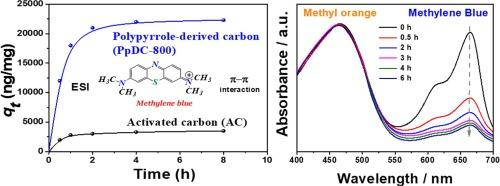聚吡咯衍生多孔碳对水中阳离子染料的吸附去除
IF 5.9
3区 工程技术
Q1 CHEMISTRY, MULTIDISCIPLINARY
Journal of Industrial and Engineering Chemistry
Pub Date : 2025-05-05
DOI:10.1016/j.jiec.2025.05.004
引用次数: 0
摘要
通过对聚吡咯的热解,在不同的制备条件下制备了聚吡咯衍生碳。经表征后,将PpDCs用于有机染料污染水体的吸附净化。一种PpDC (PpDC-800)对阳离子染料(如亚甲基蓝和结晶紫)的吸附能力(Qo)高于其他吸附剂。PpDC-800对亚甲基蓝和结晶紫的吸附量约为活性炭的7倍。PpDC-800对阳离子染料(200 mg/L)在极低浓度亚甲基蓝或结晶紫(1 mg/L)水中的有效吸附,产生毒性并影响美观。PpDC-800对阴离子甲基橙和阳离子亚甲基蓝等质量混合物的亚甲基蓝具有较高的选择性。提出了去除亚甲基蓝的可行吸附机制,如静电和π -π相互作用。采用XRD、N2吸附、拉曼光谱、SEM、XPS、zeta电位分析等技术对结构进行了表征,并确定了吸附机理。通过FT-IR、N2吸附、拉曼和SEM分析,证实了PpDC-800的易再生性。PpDC-800是一种有效、选择性去除水中阳离子染料的吸附剂。本文章由计算机程序翻译,如有差异,请以英文原文为准。

Adsorptive removal of cationic dyes from water with polypyrrole-derived porous carbons
Polypyrrole-derived carbons (PpDCs) were obtained via pyrolysis of polypyrrole under various preparation conditions. After characterization, PpDCs were used for the adsorptive purification of water contaminated with organic dyes. One PpDC (PpDC-800) exhibited the highest adsorption capacity (Qo) for cationic dyes (e.g., methylene blue and crystal violet) compared to other adsorbents. The adsorption capacity of PpDC-800 for methylene blue and crystal violet was approximately seven times higher than that of activated carbon. The effective adsorption of cationic dyes (200 mg/L) over PpDC-800 was also observed in water with very low concentrations of methylene blue or crystal violet (1 mg/L), which causes toxicity and affects aesthetics. PpDC-800 showed high selectivity for methylene blue adsorption from an equivalent-weight mixture of anionic methyl orange and cationic methylene blue. Plausible adsorption mechanisms of methylene blue removal, such as electrostatic and π–π interactions, have been suggested. Structural characterization and adsorption mechanism were confirmed using XRD, N2 adsorption, Raman spectroscopy, SEM, XPS, zeta potential analysis, and other techniques. The facile regeneration of PpDC-800 was confirmed through successive adsorption/reactivation cycles using FT-IR, N2 adsorption, Raman, and SEM analyses. PpDC-800 is one of the most promising adsorbents for the effective and selective removal of cationic dyes from water.
求助全文
通过发布文献求助,成功后即可免费获取论文全文。
去求助
来源期刊
CiteScore
10.40
自引率
6.60%
发文量
639
审稿时长
29 days
期刊介绍:
Journal of Industrial and Engineering Chemistry is published monthly in English by the Korean Society of Industrial and Engineering Chemistry. JIEC brings together multidisciplinary interests in one journal and is to disseminate information on all aspects of research and development in industrial and engineering chemistry. Contributions in the form of research articles, short communications, notes and reviews are considered for publication. The editors welcome original contributions that have not been and are not to be published elsewhere. Instruction to authors and a manuscript submissions form are printed at the end of each issue. Bulk reprints of individual articles can be ordered. This publication is partially supported by Korea Research Foundation and the Korean Federation of Science and Technology Societies.

 求助内容:
求助内容: 应助结果提醒方式:
应助结果提醒方式:


